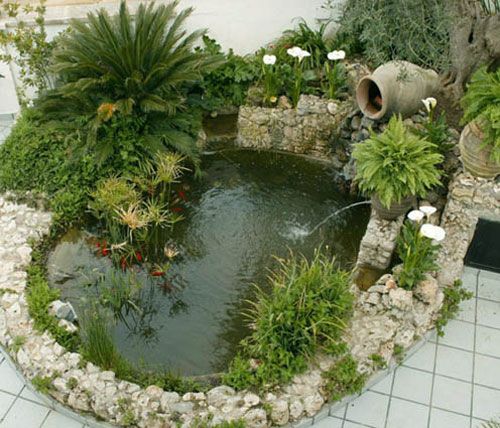If we want to have ponds at home, we must value the space and the care that we can give them to choose the vegetation as well as the possible fauna that we want to include.

If we want to have ponds at home, we must value the space and the care that we can give them to choose the vegetation as well as the possible fauna that we want to include. Lately, the idea of having ponds at home to show off a modern and elegant garden has become popular. In fact, the garden decoration is more attractive when you add a space for fish and aquatic plants. A pond allows you to include more elements of nature and will help you create a harmonious and natural environment.
Before installing the pond, you should consider that it receives direct sunlight, at least 4 hours a day. In this way, you can keep the aquatic vegetation of the pond alive. If you decide to keep fish, you should also make sure you have a fountain that keeps the water moving so it becomes oxygenated.
Depending on the vegetation, your pond can be made of water flowers or algae. If you take into account their construction, they can be made of concrete, canvas or prefabricated with plastic.
The fish also add a certain flair to the pond. You can have the same species of fish such as carp or goldfish (also known as koi and goldfish), or have different species and give the design more color.
There are several styles and ways to have ponds at home. Go ahead and choose one!
1. A waterfall for your pond.
Building ponds at home with a waterfall will make you feel closer to nature than you imagine. You can go to your garden and relax by hearing the soft sound of running water. This option looks great if you add fish or some pretty water flowers to the pond.
This design is suitable for large gardens where there is enough space to create a two-tier pond. The water will run from the highest level to the lowest.
- In order for the water to circulate constantly, the system must have an internal water pump. Make sure to cover the hoses of the pumping system under the stones or between the plants.
- Creativity is essential for this design to stand out for its beauty. At the level of the waterfall, it is advisable to put stones to simulate the natural waterfalls of the rivers.
- To border the pond, you can use bricks or flat stones. If you add fish, remember that they must be at the lowest level of the pond.
Building ponds at home with a waterfall will make you feel closer to nature than you imagine. You can go to your garden and relax by hearing the soft sound of running water. This option looks great if you add fish or some pretty water flowers to the pond.
This design is suitable for large gardens where there is enough space to create a two-tier pond. The water will run from the highest level to the lowest.
- In order for the water to circulate constantly, the system must have an internal water pump. Make sure to cover the hoses of the pumping system under the stones or between the plants.
- Creativity is essential for this design to stand out for its beauty. At the level of the waterfall, it is advisable to put stones to simulate the natural waterfalls of the rivers.
- To border the pond, you can use bricks or flat stones. If you add fish, remember that they must be at the lowest level of the pond.
2. Pond in the corner.
A corner pond is the perfect solution if you don’t have much space and you dream of having ponds at home. Enhance the decoration of your small garden by reserving a corner for fish and aquatic plants. A small well decorated corner pond will have nothing to envy other ponds.
- Considering that the garden is small, it is important not to overload the decoration of the pond so as not to visually reduce the space.
- Decorations with stones in light tones is ideal in these cases. Likewise, low plants are also an option to border the pond without overloading it.
- If you are going to put fish, think about the size they will reach when they grow and choose the species that best suits the dimensions of the pond.
Every pond needs filter systems to keep the water clean and give the water movement. If you keep the water stagnant, the fish will die from lack of oxygen and the pond will quickly become dirty. Therefore, the installation of this system is always essential.
3. Pond of aquatic plants.
Having ponds at home takes time and dedication. If you have little time for pond maintenance, this design is ideal for you. Luckily, an aquatic plant pond is fairly easy to set up and maintain.
- Build it in a circular shape and place it in a visible place for visitors. This type of pond looks great in front gardens, near the front door of your house. Also aside in your backyard.
- Create harmony between the plants in your garden and the aquatic plants in your pond without losing the opportunity to stand out. Add brightly colored water flowers that contrast with the greenery of the garden lawn. Play with the depth and diversity between plants that grow underwater and those that live on the surface.
In this type of pond, the quality of the filter is essential. Make sure you install a good filter that keeps the water clean so that you can always appreciate the vegetation inside.
Tips to have ponds at home.
Before putting fish in, measure the pH of your pond to make sure it is optimal for its survival. Consider that if you put fish, you will also create a sustainable way to control mosquitoes. The fish will eat the eggs of mosquitoes and other pests found in the pond.
Another aspect that you should take into account if you want to build a pond with fish and aquatic plants, is that the plants are not poisonous to your fish. Likewise, if you combine fish of different species, you will have to find out if they can coexist in the same space without problems. You can consult this information with an expert in the store where you buy the plants and fish.
Periodically clean the pond of organic waste such as flowers and fallen leaves to avoid having to do maintenance as often. In addition to the filter, certain aquatic plants like hyacinths can help you keep the water clean. This plant facilitates the task of having ponds at home by eliminating the nutrients that contribute to the formation of algae.


